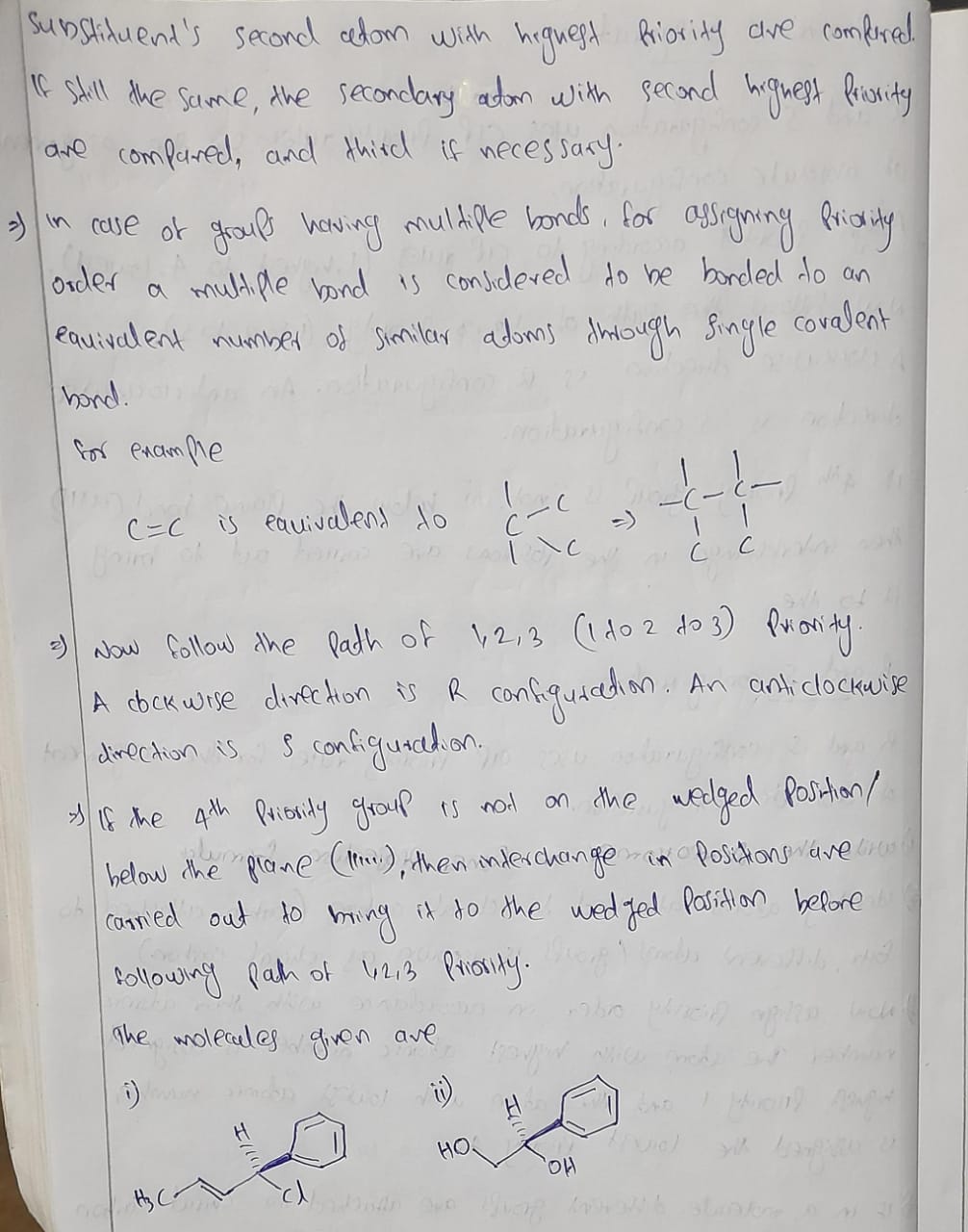Chemistry
10th Edition
ISBN:9781305957404
Author:Steven S. Zumdahl, Susan A. Zumdahl, Donald J. DeCoste
Publisher:Steven S. Zumdahl, Susan A. Zumdahl, Donald J. DeCoste
Chapter1: Chemical Foundations
Section: Chapter Questions
Problem 1RQ: Define and explain the differences between the following terms. a. law and theory b. theory and...
Related questions
Question
Assign the stereochemical configuration (R or S) for each molecule. Show your work, indicating clearly which groups are assigned which priorities (#1 through #4) (e.g. by including the priority # directly adjacent to one of the atoms in that group).

Transcribed Image Text:The image displays two chemical structures labeled (i) and (ii).
**Structure (i):**
- This molecule contains a benzene ring attached to a carbon chain which includes a chlorine atom (Cl).
- The molecule has a chiral center indicated by the wedge representation of the hydrogen (H) and chlorine group.
- The structure consists of a carbon with three bonds: a benzene ring, a chlorine atom, and a chain terminating with a methyl group (CH₃).
**Structure (ii):**
- This molecule also contains a benzene ring, similar to structure (i).
- It has an additional hydroxyl group (OH) indicated by the wedge representation of hydrogen (H) and an OH group, suggesting the presence of another chiral center.
- The structure involves a carbon attached to a benzene ring, two hydroxyl groups, and another carbonaceous structure.
### Explanation for Education:
- These structures illustrate stereochemistry, where the spatial arrangement of atoms is significant and affects molecular function.
- The representations with wedges highlight the three-dimensional orientation of specific groups, essential for understanding chirality.
- Analyzing these structures helps in understanding reactions where orientation and chirality influence reactivity and product formation.
Expert Solution
Step 1: Note on Assigning the stereochemical configuration (R or S)
 l
l
Step by step
Solved in 4 steps with 4 images

Knowledge Booster
Learn more about
Need a deep-dive on the concept behind this application? Look no further. Learn more about this topic, chemistry and related others by exploring similar questions and additional content below.Recommended textbooks for you

Chemistry
Chemistry
ISBN:
9781305957404
Author:
Steven S. Zumdahl, Susan A. Zumdahl, Donald J. DeCoste
Publisher:
Cengage Learning

Chemistry
Chemistry
ISBN:
9781259911156
Author:
Raymond Chang Dr., Jason Overby Professor
Publisher:
McGraw-Hill Education

Principles of Instrumental Analysis
Chemistry
ISBN:
9781305577213
Author:
Douglas A. Skoog, F. James Holler, Stanley R. Crouch
Publisher:
Cengage Learning

Chemistry
Chemistry
ISBN:
9781305957404
Author:
Steven S. Zumdahl, Susan A. Zumdahl, Donald J. DeCoste
Publisher:
Cengage Learning

Chemistry
Chemistry
ISBN:
9781259911156
Author:
Raymond Chang Dr., Jason Overby Professor
Publisher:
McGraw-Hill Education

Principles of Instrumental Analysis
Chemistry
ISBN:
9781305577213
Author:
Douglas A. Skoog, F. James Holler, Stanley R. Crouch
Publisher:
Cengage Learning

Organic Chemistry
Chemistry
ISBN:
9780078021558
Author:
Janice Gorzynski Smith Dr.
Publisher:
McGraw-Hill Education

Chemistry: Principles and Reactions
Chemistry
ISBN:
9781305079373
Author:
William L. Masterton, Cecile N. Hurley
Publisher:
Cengage Learning

Elementary Principles of Chemical Processes, Bind…
Chemistry
ISBN:
9781118431221
Author:
Richard M. Felder, Ronald W. Rousseau, Lisa G. Bullard
Publisher:
WILEY